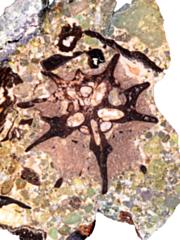Project 3460: F. Herrera, M. R. Carvalho, C. Jaramillo, S. R. Manchester. 2019. 19-Million-Year-Old Spondioid Fruits from Panama Reveal a Dynamic Dispersal History for Anacardiaceae. International Journal of Plant Sciences. 180 (6):000-000.
Abstract
Premise of research. Recent classifications of Anacardiaceae recognize two subfamilies, Anacardioideae and Spondioideae. Most genera within Spondioideae are still recognized for having drupes with sclerified stones that vary in locule number and germination mechanisms. Spondioid fruits have been recognized in the Cenozoic fossil record of Europe, Asia, and North America. However, they have remained elusive in the Neotropics, where today, they are an important component of tropical rainforests and seasonally dry tropical forests. Here, we describe three new species of fossil endocarps related to Spondias, Dracontomelon, and Antrocaryon.Methodology. Fossil endocarps were collected from the 19–18.5 Ma (early Miocene) Cucaracha Formation, Panama Canal. The fossils were studied by physical sections, acetate peels, and X-Ray microtomography. The fossil endocarps were exhaustively compared with all extant genera of Spondioideae.
Pivotal results. Spondias rothwellii sp. nov. and Antrocaryon panamaensis sp. nov. are so far the earliest and best evidence of these genera in the Neotropics. Dracontomelon montesii sp. nov. extends the occurrence of this genus to the early Miocene in Central America.
Conclusions: The new Cucaracha fossils reveal that Spondioideae were a significant part of the early Miocene forests in Panama. The extant natural habitats and occurrences of the newly recognized genera suggest multistratified rainforests and active biogeographical patterns for Spondioideae approximately 19 million years ago in southern Central America.
Read the article »
Article DOI: 10.1086/703551
Project DOI: 10.7934/P3460, http://dx.doi.org/10.7934/P3460
| This project contains |
|---|
Download Project SDD File |
Currently Viewing:
MorphoBank Project 3460
MorphoBank Project 3460
- Creation Date:
18 April 2019 - Publication Date:
30 May 2019
This research
supported by
Authors' Institutions ![]()
- University of Florida
- Chicago Botanic Garden
- Smithsonian Tropical Research Institute

